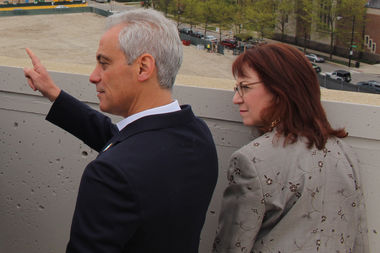
GOOSE ISLAND — The question of what to do with the North Branch Industrial Corridor soon will be answered.
Mayor Rahm Emanuel has unveiled a final "framework" for the area that prioritizes the corridor's revenue-generating prospects, potentially at the expense of parkland residents and aldermen have been fighting for at the site.
But 2nd Ward Ald. Brian Hopkins said he'd received assurances that the mayor's plan guarantees no less than 10 acres of parkland "to be dedicated for ballfields, playgrounds and additional open park space for public recreational use."
Emanuel's final framework released late Monday was light on specifics on where that parkland would come from.

Ald Michele Smith (43rd) has been fighting to secure a major new park of 15 acres for the neighborhood, backed by Hopkins, 32rd Ward Ald. Scott Waguespack and a dozen community groups that she said make up 350,000 residents.
Emanuel said the framework will "generate revenue from this thriving area to support industrial businesses throughout Chicago.
"Now we move forward to the next step in the process, which will bring together the North Branch stakeholders to turn this plan into concrete progress for the community," Emanuel said.
The North Branch Industrial Corridor is the first of 26 industrial areas citywide to get a "modernization plan" that will guide development for decades. The plan will set goals and standards for the 760 acres along 3.7 miles of the Chicago River between Kinzie Avenue and the Fullerton Avenue Bridge.
The plan sets three primary goals to "maximize the North Branch as an economic and vital job center," shifting the emphasis from manufacturing to information and technology; to "provide better access for transportation," with an extension of the 606 trail across the river and better bridges improving access to Goose Island; and to "enhance natural resources," primarily through a riverwalk and wetlands park.
Emanuel's framework has Hopkins' support. The alderman said he secured pledges from administration officials Monday that the final framework would set aside "no less than" 10 acres for parks and would include ballfields.
"As you know, I've advocated from the beginning of the process that we accommodate open space needs for our community," Hopkins said. "While I recently noted objections and concerns to the open space treatment in the modernization plan, I’m encouraged that there’s been a recognition to accommodate the needs of neighbors and young families in nearby impacted neighborhoods."
The final framework mentioned that 60 acres would be set aside for "open space," likely a riverfront trail and a wetlands park in the turnaround basin at the north end of Goose Island at North Avenue.
But Emanuel's new framework inserted language that "no less than 10 of these 60 acres of open space should be for recreation to achieve a principle [sic] goal of this framework plan."
The newest plan also says that open space could include infrastructure for "single-purpose activities like skate parks and athletic fields."
Otherwise, little was changed from earlier plans for the corridor.
Untouched was a promise to "create publicly accessible open spaces within planned developments for recreational activities." It cited as examples the 1.5 acres of open space at the base of the new River Point skyscraper on the river where it divides Downtown, and a soccer field that was built as part of a development at 31st Street and Kedzie Avenue.
Smith has said the riverwalk and wetlands park would be insufficient for the community's needs, as major parks like Oz Park are already overburdened and will be additionally taxed by new residences north and south of Goose Island.
Smith encouraged residents to lobby for a major new park when the framework plan is submitted to the Plan Commission for approval May 18.



















